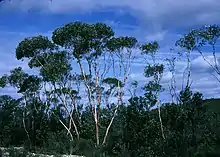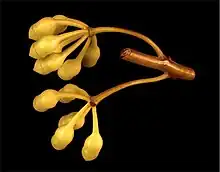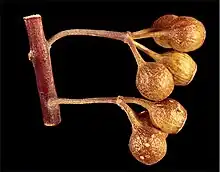| Slender mallee | |
|---|---|
 | |
| Scientific classification | |
| Kingdom: | Plantae |
| Clade: | Tracheophytes |
| Clade: | Angiosperms |
| Clade: | Eudicots |
| Clade: | Rosids |
| Order: | Myrtales |
| Family: | Myrtaceae |
| Genus: | Eucalyptus |
| Species: | E. decurva |
| Binomial name | |
| Eucalyptus decurva | |
Eucalyptus decurva, commonly known as the slender mallee,[2] is a species of mallee that is endemic to the south-west of Western Australia. It has smooth whitish bark, lance-shaped to curved adult leaves, pendulous flower buds arranged in groups of seven, white flowers and pendulous, more or less spherical fruit.


Description
Eucalyptus decurva is a mallee that typically grows to a height of 1.5–5 m (4 ft 11 in – 16 ft 5 in) and forms a lignotuber. The bark is smooth, white-gray, salmon to yellow-green and sometimes powdery. Young plants and coppice regrowth have dull greyish green leaves arranged in opposite pairs, oblong to elliptic or egg-shaped, 35–105 mm (1.4–4.1 in) long and 30–70 mm (1.2–2.8 in) wide. Adult leaves are arranged alternately, glossy green, lance-shaped to curved, 50–105 mm (2.0–4.1 in) long and 12–25 mm (0.47–0.98 in) wide on a petiole 10–20 mm (0.39–0.79 in) long. The flower buds are pendulous and arranged in leaf axils in groups of seven on a peduncle 10–25 mm (0.39–0.98 in) long, the individual buds on a pedicel 4–10 mm (0.16–0.39 in) long. Mature buds are more or less cylindrical to pear-shaped, 5–10 mm (0.20–0.39 in) long and 4–5 mm (0.16–0.20 in) wide. Flowering occurs between April and October and the flowers are white to pale pink. The fruit is a pendulous, woody, more or less spherical capsule 7–11 mm (0.28–0.43 in) long and 7–10 mm (0.28–0.39 in) wide on a pedicel 3–12 mm (0.12–0.47 in) long.[2][3][4]
Taxonomy and naming
Eucalyptus decurva was first formally described in 1863 by Ferdinand von Mueller from a specimen collected by George Maxwell near the Porongurups and the description was published in Fragmenta phytographiae Australiae.[5][6] The specific epithet (decurva) is a Latin word meaning "down-curved", referring to the flower buds.[3]
Distribution and habitat
Slender mallee grows in sandy and lateritic soils in hilly coastal and near-coastal areas, mostly between the Stirling Range and Esperance but with disjunct populations near Perth.[2][4]
See also
References
- ↑ "Eucalyptus decurva". Australian Plant Census. Retrieved 27 May 2019.
- 1 2 3 "Eucalyptus decurva". FloraBase. Western Australian Government Department of Biodiversity, Conservation and Attractions.
- 1 2 "Eucalyptus decurva". Euclid: Centre for Australian National Biodiversity Research. Retrieved 4 June 2020.
- 1 2 Chippendale, George M. "Eucalyptus decurva". Australian Biological Resources Study, Department of the Environment and Energy, Canberra. Retrieved 27 May 2019.
- ↑ "Eucalyptus decurva". APNI. Retrieved 27 May 2019.
- ↑ von Mueller, Ferdinand (1863). Fragmenta Phytographiae Australiae. Vol. 3. Melbourne: Victorian Government Printer. pp. 130–131. Retrieved 2 April 2023.